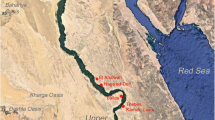Abstract
The first workshop evidence of the Caliphate polychrome tin-glaze production known as ‘verde y manganeso’ in al-Andalus has been found in the Cordoban workshops area. This study reports on the analysis of recovered firing debris and workshop items and the tin glaze production chaîne opèratoire using SEM-EDS and μ-XRD analysis. The findings reveal the use of a tin and lead calx mixed with plant ashes both in the Emirate and later Caliphate tin glaze productions and demonstrate a direct relationship between the Umayyad Córdoba-Madīnat al-Zahrā’ and the Abbasid regions. Moreover, ceramics from both domestic and palatial well-dated archaeological contexts from Córdoba and Madīnat al-Zahrā’ have been analysed to determine the differences among the domestic and palace wares and to shed light on the long running dispute among scholars regarding the location of the tin-glazed workshops. Our data demonstrate so far that the workshop area of Córdoba manufactured ‘verde y manganeso’ tin-glazed ceramics during the Caliphate period and that it could have been supplying both high-quality wares for the palaces and cheaper products for the domestic contexts.











Similar content being viewed by others
Notes
All the DMS geographical coordinates included in the manuscript refer to the archaeological sites. All are reporting coordinates, taken by the survey teams, that have been included in the archaeological reports for the four Córdoba archaeological sites and from VALLEJO (2010) for Madīnat al-Zahrā’.
References
Allan JW (1973) Abu’l-Qasim’s treatise on ceramics. Iran 11:111–120
Al-Maqqarī (1855) In: Dozy R, Dugat G, Krehl L, Wright W (eds) Analectes sur l’histoire et la littérature des Arabes d’Espagne, vol 2, Leyden
Aziz Salem A (1984-85) Centros industriales de la cerámica hispano-musulmana en las crónicas árabes. Awraq 7-8:227–229
Barceló M (1993) Al-mulk, el verde y el blanco: la vajilla califal omeya de Madīnat al-Zahrā. I Encuentro de Arqueología y Patrimonio: la cerámica altomedieval en el sur de al-Andalus (Salobreña, 1990), edited by A. Malpica. Granada, pp 291–299
Camacho C, Valera R (2020) Familias y técnicas decorativas en cerámica vidriada. Arrabales occidentales de Madinat Qurtuba (siglos IX-X). In: Coll J, Salinas E (eds). Tecnología de los vidriados en el oeste mediterráneo: tradiciones islámicas y cristianas. Valencia: 63-88.
Cánovas A, Moreno M (2005) Informe memoria de los resultados de la A.A.Pre. realizada en los terrenos proyectados para la futura piscina municipal de poniente de Córdoba. (unpublished work).
González M (2002) Informe memoria de la Intervención Arqueológica de Urgencia en el enlace de la prolongación de la avenida de América con la avenida del periodista Quesada Chacón (glorieta Ibn-Zaydun de Córdoba) (unpublished work)
Larrea I (2008) Memoria preliminar de la A.A.Pre en el E.D. SC3-Zumbacón (Córdoba) (unpublished work)
Matin M, Tite M, Watson O (2018) On the origins of tin-opacified ceramic glazes: new evidence from early Islamic Egypt, the Levant, Mesopotamia, Iran, and Central Asia. J Archaeol Sci 97:42–66
Ocaña M (1970) El cúfico hispano y su evolución, Madrid
Ortiz R, León E (2018) Memoria preliminar Actividad arqueológica preventiva- control arqueológico Patio sur del Palacio Episcopal de Córdoba (unpublished work)
Rosselló G (2002) Cerámica califal, cerámicas periféricas. Una aproximación a la cerámica andalusí de los siglos X-XI. El Califato de Córdoba. Córdoba, pp 67–104.
Salinas E (2012) La Cerámica Islámica de Madinat Qurtuba de 1031 a 1236: Cronotipología y centros de producción. PhD Thesis, Universidad de Córdoba. <http://hdl.handle.net/10396/7830>.
Salinas E, Pradell T (2018) The transition from lead transparent to tin-opacified productions in the western Islamic lands: al-Andalus, c. 875-929 CE. J Archaeol Sci 94:1–11
Torres L (1970) Ciudades hispanomusulmanas. Tomo I. Madrid
Vallejo A (2010) La ciudad califal de Madīnat al-Zahrā’. Jaén
VVAA (2015) Madinat al-Zahra: Catálogo de la exposición permanente. Madrid
Watson O (2004) Ceramics from Islamic Lands. London
Acknowledgements
We would thank the directors of the archaeological excavations of Córdoba, Isabel Larrea, Raimundo Ortiz, Juan Murillo, Marina González, Álvaro Cánovas and Maudilio Moreno, and the Instituto Valencia de Don Juan, Museo Arqueológico de Córdoba, Madinat al-Zahra Archaeological Ensemble and Manuel Retuerce (colección Casamar) for their helpful contribution and providing the samples analysed. Thanks are also due to two anonymous reviewers who further improved our text with suggestions and questions.
Funding
This project has received funding from the European Union’s Horizon 2020 research and innovation programme under the Marie Skłodowska-Curie grant agreement IGATO N° 702019. We are grateful to the funds received from Ministerio de Ciencia e Innovación (Spain) project MAT2016-77753-R and Generalitat de Catalunya project 2017-SGR-00042. The μSR-XRD experiments were performed at BL13 XALOC beamline at ALBA Synchrotron Facility with the collaboration of ALBA staff.
Author information
Authors and Affiliations
Corresponding author
Additional information
Publisher’s note
Springer Nature remains neutral with regard to jurisdictional claims in published maps and institutional affiliations.
Rights and permissions
About this article
Cite this article
Salinas, E., Pradell, T. Madīnat al-Zahrā’ or Madīnat Qurtuba? First evidences of the Caliphate tin glaze production of ‘verde y manganeso’ ware. Archaeol Anthropol Sci 12, 207 (2020). https://doi.org/10.1007/s12520-020-01170-7
Received:
Accepted:
Published:
DOI: https://doi.org/10.1007/s12520-020-01170-7




